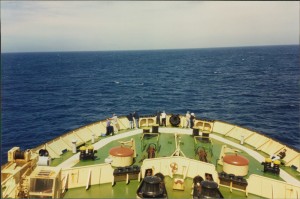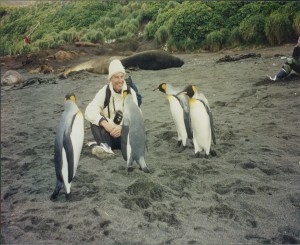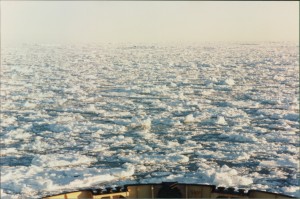ANTARCTICA 1998
A journey is a person in itself; no two are alike.
And all plans, safeguards, policies and coercion are fruitless.
We find after years of struggle that we do not take a trip;
a trip takes us.
– John Steinbeck.
During the next few weeks I will be posting some extracts from the diary of our expedition to Antarctica on a Russian Icebreaker in January/ February 1998.
The ship Kapitan Khlebnikov is classed amongst the world’s powerful icebreakers. She was built in Finland in 1981. Length: 132.49 metres, Breadth: 26.5 metres, Draught: 8.5 metres, Displacement: 18,000 tons, Cruising speed: 16 knots, Full icebreaker class, 2 Helicopters on board, 6 Mark V heavy duty zodiacs. 60 Russian crew members, 12 Expedition Staff, 4 Helicopter pilots. 1 Doctor. And 100 passengers.
22 January 1998.
What a welcoming sight for the start of an adventure of a lifetime, as we turned onto Macquarie Wharf in Hobart to see a large yellow and black ship dominating the skyline. She was a tough looking vessel easily capable of negotiating the world’s roughest seas and crashing through miles of the densest pack-ice.
We are soon aboard, checking our very comfortable cabins, stowing luggage and a tour of the decks. looks good for the next three weeks. A pre-departure briefing, meeting the staff and the other formalities were soon over. Departure was at 18:15 and we watched Hobart slowly disappear. Life jacket and our first life-boat drill was next, followed by dinner at 19:30. We were on our way.
It has always been a long held ambition of mine to sail to the south polar regions and to visit Antarctica, and I had a partner who has grown to become as keen as I was, thank you Frances. I had always suffered from seasickness in my younger years, but I started dinghy sailing with my son, Philip, at our local yacht club and overcame the problem. Our subsequent sailing experiences over the next 20 years is a subject for another time. So we are on our way and not being afflicted with sea sickness was a definite advantage on this occasion.
Out of the Derwent River turn to starboard and head south, then after clearing Bruny Island we are in the Great Southern Ocean and beginning to roll, not too serious yet but a taste of what’s to come. The meal was the first of many fine meals.
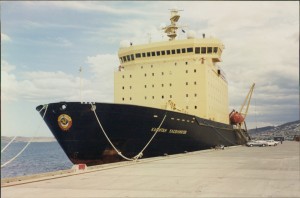
23 January
The morning bought forth sunshine and a gently rolling sea and no land to be seen. Some were having trouble finding their sea legs, and were a little under the weather. However there was a good turnout to a hearty breakfast. Time for a stroll around the deck in an already chilly breeze, before our first lecture.
The lecture theater was full to hear Luke Saffigna, a naturalist from Hobart, deliver a talk about Macquarie Island and its new World Heritage listing. We were to find out later this was a really special place. Nick Mooney, an Ornithologist also from Hobart, followed later with a talk entitled Petrelheads, which inspired the Birdos among us.
The afternoon was free and many took the opportunity to visit the bridge and for some wildlife spotting. The bridge is open 24 hours a day to visit and practice a bit of Russian and talk navigation and all that stuff with crew who are also keen to practice their English. The Expedition Leader, Stewart Campbell can often be found on the bridge and is always good for a chat.
Wildlife spotted for the day included: Black-browed and Wandering Albatross, Little Shearwaters and White-chinned Petrels. ‘Whalo’ was called when two rare beaked whales were spotted and identified by our experienced Assistant Expedition Leader – Jennifer Clement – from Long Island, NY, USA. Other sightings included a strange looking orange buoy and a fur seal.
This evening we all met in the lounge for the Welcome Cocktail Party, hosted by Captain Viktor Vasil’yew, followed by a sumptuous Captains Welcome Dinner.
We retired to our cabin which was located on deck 5, amid ship under the bridge. It was a large square cabin, with bathroom and bedroom along the back and a lounge with an L shaped desk, a settee, 2 easy chairs and 2 opening portholes to front. It had all the electrics, phone, intercom, comfortable bed and every thing you could wish for. It was a fabulous cabin really, but we would find out later that in rough weather it was far too big.
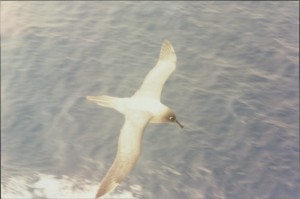
24 January, At Sea
The temperature had dropped markedly and the swell had increased, but we were experiencing surprisingly good conditions for the Southern Ocean, with the ship averaging a very good speed of 12 knots.
Our lectures today included an important briefing on the protocol of wildlife viewing, and general guidelines on Macquarie Island. Sid Kirby, a very experienced Antarctic adventurer, from Flaxton in Queensland, told stories of his experiences on the cold continent and his crossings from Hobart on much smaller vessels. Sid was a dog sled driver in the days before mechanical transportation became available. Margie Morrice a Hobart Marine Biologist gave us all the information about the Southern Elephant Seals on Macquarie Island, and how they have adapted to their current conditions.
Wildlife today included a pod of Killer Whales. They appeared to be fishing as we sailed right through the pod. Then there were the Mottled Petrel and Grey Petrels. These small birds hang around the ship, possibly waiting for some handouts from the kitchen disposals.
Much of the rest of the day was spent in preparation for our landing in the sub-Antarctic, with briefings from Stewart on clothing and safety guidelines for Zodiac operations.
Below decks, people are meeting and forming lasting friendships. Tomorrow will be an exciting day with our landing on Macquarie Island.
25 January, Macquarie Island
The most wretched place of involuntary and slavish exilium
that can possibly be conceived;
nothing could warrant any civilised creature living on such a spot.
-Captain Douglas, about Macquarie Island 1822.
Many were up very early to catch that first glimpse of Macquarie Island and were rewarded with the sight of Royal and King Penguins porpoising along next to the ship. The island soon slowly appeared from the cloud and the fog. It seemed everyone was up as we sailed into Buckles Bay and got our first good look at this sub-Antarctic Island. And would you believe a pod of Killer Whales swam close by as we dropped anchor. ANARE station, home to 15 people during the winter months and up to 40 scientists and support staff over the summer months, is clearly visible, as is the historic North Head and Wireless Hill, where Sir Douglas Mawson set his radio station during the 1914 Australian Antarctic Expedition. Old donga lines and nissan huts are still in use and the latest technology is represented by the massive Geodesic satellite dish dome.
To most of us the first landing was a thrill to behold, with cameras loaded and film in our pockets the adventure had moved to the next phase. For some of the others, the sheer fact of standing on land again was a huge relief. We will never forget wandering among King Penguins and Rockhopper Penguins in Garden Cove. They are very inquisitive and follow you around and peck at our boots but generally make an incessant, continuous noise and then there is the strong odour. There were also the Gentoos and smaller Royal Penguins with a little crown on their heads. Bird life was represented by the Giant Petrels and Skuas (the scavengers). Light-mantled Sooty Albatross (Sootys), Terns and Prions.
Old machinery and boilers from the sealing days lay about amongst the tall arctic grasses, as do the huge Elephant Seals.
Time for a quick look around the station, buy some stamps and souvenirs at the post office, before we are hurried back to the ‘Khleb’ in the Zodiacs. We then sailed slowly down the East coast of the Island in the hope we may go ashore again, but a sudden gail put pay to that idea, so we cruised carefully back to our safe anchorage to spend a quiet peaceful night. But not before a lot of chatter and comparing of the days events. Check out our ships Doctor talking to the penguins.
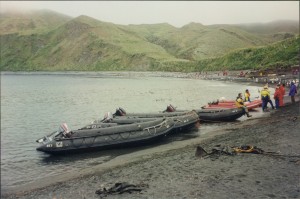
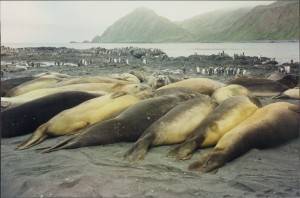
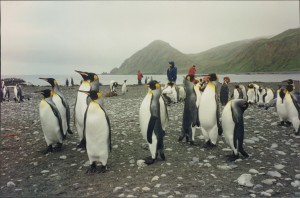
26 January
Early rise today, the gale has abated and we slowly make our way south again and anchor in Sandy Bay. Its OK to go ashore this morning to view two large breeding colonies of Royals and Kings and a large group of Elephant Seals. There are 40,000 penguins in the Royal colony all flapping and screeching and protecting their chicks from the ever persistent skuas. Further south we drift past the 160,000 colony of Kings, with their accompanying odor. So with our fill of Macquarie Island we head off into the Southern Ocean to continue rolling South.
The afternoon lecture was about the southern lights (Aurora Australis), and we were encouraged to keep a lookout for the phenomenon. Would you believe that night at 21:00 we had a perfect display in the southern skies.
27 January
Routine has established an eat, sleep, lecture, eat, sleep, lecture, spotting wildlife, pattern, which will continue for the remainder of the trip. Our next expectation will be an iceberg. It is day 6 and we are in the vicinity of the Antarctic Convergence line, where the very cold Antarctic waters meet the warmer sub-Antarctic waters, which creates a nutrient-rich zone that supports a concentration of life. Sure enough pilot whales and beaked whales were sighted. The sea temperature today is 2 deg Celsius. It has been another great day and worth a beer or two.
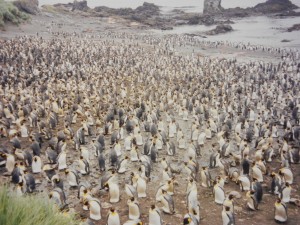
Pushing through sea ice.
28 – January
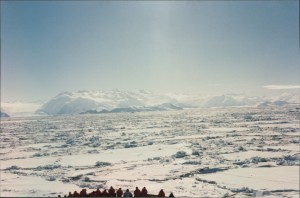
The ice was here, the ice was there,
the ice was all around.
It cracked and growled and roared and howled
like noises in a swound.
– Samuel Coleridge – The Ancient Mariner.
A big turnout again for breakfast this morning, in expectation of an eventful day ahead. The seas had settled considerably with slushy, melting sea ice smoothing the waters. The bridge was a popular place with an increase in Antarctic birdlife and the presents of Minke whales and a pod of Humpbacks venturing close to the ship. Lectures continued and included a talk from Mike Prebble, from New Zealand, on the history of the exploration huts and the Antarctic Treaty System. we also had a briefing on helicopter protocol and the safety considerations. We were to fly over Balleny Island this afternoon but the weather became unfavorable so that trip was aborted. The bar was well supported this evening, it’s amazing what a difference a flat sea makes, as conviviality and frivolity continued into the night. Not that the nights are very long because we are well into the hours of the midnight sun.
29 January
This morning I was on the bridge for my regular search of the horizon, after all it is what I have always done at sea, when to my surprise I sighted land in the distant south. We are still 100 miles from Antarctica, so a query of my sighting to the officer of the watch confirmed it was land. He tweaked the radar up to the 120 nautical mile setting and sure enough there it was. It was a beautiful, clear, sunny morning and it soon became an awe-inspiring sight of the distant mountains of Victoria Land, on Antarctica, at the amazing distance of 100 nm away. We are heading towards Cape Adare where we will make our first Zodiac landing on the Continent. Wildlife is becoming more abundant as we are closer to the continent. Penguins, birds, orcas, seals, whales, any time any direction there is always something to see.
Cape Adare is on the northern tip of the Ross Sea, and was the sight of the first over-wintering expedition in Antarctica, led by Carsten Borchgrevink, on the Southern Cross expedition of 1899. It is also the sight of a colony of 1,000,000 Adelie Penguins. As we get closer we sight the hut and get a whiff of the penguins.
This an amazing place when ashore. The small hut and is in exceptional condition and the sight of 1,000,000 penguins, well its awesome, unbelievable, I guess you had to be there.
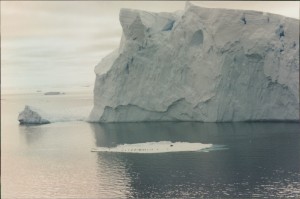
30 January
Glittering white, shining blue, raven black,
in the light of the sun the land looks like a fairy tale.
Pinnacle after pinnacle, peak after peak, crevasses,
wild as any land on our globe,
it lies unseen and untrodden.
– Ronald Amundsen.
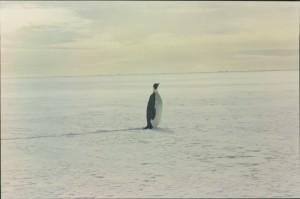
Flavor of the day were Minkes, humpbacks and killers with one addition, and that was a solitary Emperor Penguin. It is not the season for Emperors, but we did see a few now and then.
Today was to be our our first helicopter adventure, and we were not disappointed. We flew over Coulmen Island, with its hanging glaciers, huge, sheer cliffs and ice falls. This island is a breeding ground for the Emperor Penguin. Meanwhile the ‘Khleb’ is punching her way through 1 meter thick ice, with ease I might add, on our way to Franklin Island.
31 January
Franklin Island; We had to wait until mid morning for a strong wind to abate, it was blowing ice onto our small beach, before we could attempt a landing. We can get four seasons in one day, and often do, but we have 24 hours of sunlight so we are not going to run out of daylight. Even though our body clock knows when its bed time.
The procedure for a landing goes something like this: Firstly the ‘Khleb’ positions for a safe exit if required. Then a couple of Zodiacs go ashore and find a suitable area to land, where the beach is not too steep, or where we won’t be blocked in by ice and is generally safe. They then unload a heap of safety gear and emergency supplies just in case of a stranding and a gale prevents a helicopter rescue. All this is done very quickly and efficiently, then its time to go ashore. This time its an Adelie Penguin rookery with a tall ice cliff at the end of the beach. Our next stop was to be the Ross Ice Shelf.
The Ross Ice Shelf, was named after James Clark Ross, who explored the area in 1841. It is a floating piece of ice with a 500 km coast. It is over 40 m thick and has an area greater than the size of France. The ice shelf is actually a huge glacier. It is fed by hundreds of glaciers flowing from the mountains of Antarctica, and it was the original route taken by the early explorers to reach the mainland of the continent.
The ‘Khleb’ cruised slowly along the cliff face, and later in the day the helicopters ferried us to a spectacular landing on to the wind swept ice. The temperature with wind chill factor was minus 30 deg Celsius. We kept warm by striking out towards the south pole and drinking hot rum cocktails. It bought home to us what the early explorers had to endure. What an impressive and vast landscape this is, and how daunting it would have been, those many years ago.

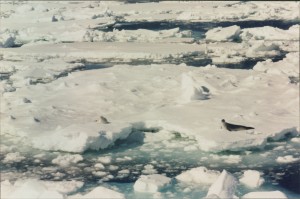
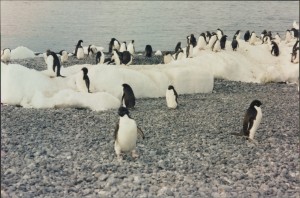
1 – February
An Antarctic Expedition is the worst way to have the best time of your life. – Apsley Cherry-Gerrard.
Today we will attempt three landings on the western side of Ross Island. Cape Bird has another Adelie colony and the New Zealand field base. Skuas on the beach are guarding their fluffy chicks and we try to avoid being divebombed. The skuas are the garbage collectors, cleaning up any dead or weak birds or animals. Are penguins birds or animals? They don’t fly, but they lay eggs, they are fast swimmers, but are not fish, a clue – they have feathers. They are of course flightless birds.
Cape Royds: Shackleton’s Hut is here as is the southernmost penguin colony. An emergency was becoming apparent here after the first landing, when the fast ice began to break up in Backdoor Bay behind Cape Royds, leaving those on the ice to make a hasty retreat back to the zodiacs. It showed the true adventurous nature of this trip and ability of the staff and passengers to respond quickly to a challenging situation.
So now to Cape Evans and to Scott’s famous hut from where he launched his ill fated 1911-13 expedition to the south pole. It is difficult not to moved while inside any of these huts. They have been left and untouched since the expeditioner left them, possibly in haste. They have literally been in the freezer for a hundred years. Still the reindeer sleeping bags on the bunks with socks hanging from above and pencil sketches on the walls. Hay still in perfect condition, Scott had Siberian horses for his quest to the pole. A whole side of mutton hanging, waiting to be cooked. Shelves of medical supplies, cartons of food, chocolate and cocoa, and the list goes on. One would think that at any time one of the adventurers could walk in the door to make the room complete.
It was minus 10 deg. Celsius but a few stood out side on the decks to marvel at the sight of the low sun reflecting views of Mt Erebus complete with a whisk of steam to enhance the colors as it moved in a low ark behind it.
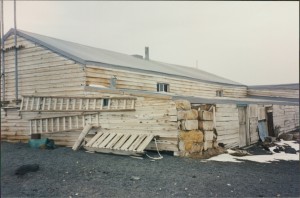
2 – February
McMurdo Sound is the site of Discovery Hut situated in the shadows of the station on Hut Point, from where Scott spent the two winters of his first expedition in 1902-03. A short distance from here on a small knoll overlooking the hut, is a lone cross which pays tribute to George Vince, who was blown off a cliff into the frigid sea during a blizzard. What a cruel climate this can be.
The US McMurdo Station is only a short walk away, and we are given a very interesting guided tour of the facility. The brightly coloured buildings contrast with the white background of the landscape behind. The New Zealand Scott Base is a is few minutes away by helicopter. It is more compact and homely than the US base. We share a few Kiwi Jokes and buy some souvenirs before returning to the Khleb. A Great visit.
We leave McMurdo in the evening escorted by a large pod of Orcas The count was 102, believe me.
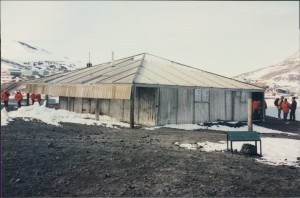
3 – February
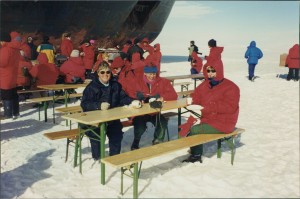
From whose womb did the ice come forth?
and who has given birth to the frost of heaven?
-Job 38, 29
The Dry valleys. Excellent weather this morning and a helicopter ride takes us up into the dry valleys where a new phenomenon greets us as we land and wander around the valley floor. Where is the ice and the snow? None to be seen, save for the glaciers on the mountains on each side of the valley. Where we are standing is as dry as a desert. There is a 600 hundred year old mummified seal, several miles from the sea, how did he get there? No body realy knows. This valley is extensive, several miles wide and many, many miles long, all dry, why we ask? There are areas of rare mosses and lichen on the wind sculptured rocks. We have landed close to the Canada Glacier with glistening droplets of water on its cliff face.
The reason for the dryness is that very cold and strong katabatic winds blow down the valley carrying all ice and snow before it, leaving stone and bedrock behind. Another amazing place.
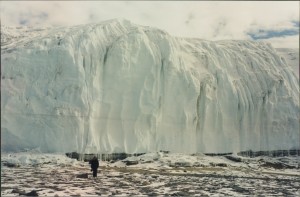
Back on the ‘Khleb’ and we make another attempt to visit the 1906 hut, of Ernest Shackleton’s expedition at Cape Royds. This time we all make a successful landing and waited our turn to visit inside the hut, numbers in the huts is strictly monitored, for obvious reasons. This is a much smaller hut than Scott’s hut, but no less moving to imagine the men living and working in these surroundings, there is a sense of unfinished business. Was it a refuge, a home or a prison? I am sure at times it was all three.
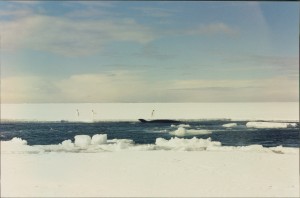

4 – February
If its possible to imagine a piece of beef, odoriferous cod fish
and a canvas backed duck roasted together in a pot,
with blood and cod-liver oil, the illustration would be complete.
– Dr Frederick Cook, the Belgica Expedition 1885,
on what penguins taste like.
Perfect weather again to day, sun shining no wind. We are crashing through thick pack ice flows as we pass the spectacular Drygalski Ice Tongue, towards Terra Nova Bay. A chance to see Crabeater and Weddell seals up close. We are by now heading North and the evenings are becoming darker.
We make a visit to the Italian station which situated on the best real estate in Antarctica, at Terra Nova Bay, with rolling granite hills and the impressive volcano of Mt Melbourne dominating the skyline. The base consists of a number of modified shipping containers which are used over the summer but locked up to become an automated station during the winter, when every one packs up and goes home. We had an informative tour of the station and enjoyed great hospitality.
As the sun became very low in the sky we cruised along the 10 mile long ice tongue of the Campbell Glacier, in the Zodiacs. The ice scenery here was very impressive with the extraordinary shapes and colors and the occasional ice falls from the tongue. Many of the icebergs here are born from this ice tongue and the ‘Khleb’ and the Zodiacs are weaving in among them. Really, really, awesome.
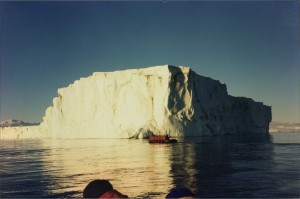
5 February
To dine with a glacier on a sunny day is a glorious thing
and makes feasts of meat and wine ridiculous.
The glacier eats hills and drinks sunbeams.
– John Muir
We have a night of clear, open sea, but as we approach Cape Hallett the ice becomes heavier, but the weather remains quiet and the sun still shining. Still lots of Minke whales and seals on the way. We are unable to make a Zodiac landing because the ice had completely closed the landing area. The Captain instead nudged the ship into an inlet and parked in the fast ice. The staff tested the ice before we all walked down the gangplank and feel the freedom from the confinement of the ship again. Scenic flights were quickly arranged to fly over these spectacular surroundings.
Well after the stimulating flights, champagne was served on the ice, and a group photo arranged under the bow of Kapitan Khlebnikov. Another day in ‘paradise’?
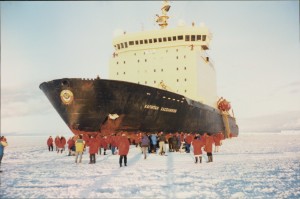
6 – 7 February
Today we loose the sight of Antarctica, but not before sailing past the beautiful Possession Islands, and some indeed missed these magnificent islands and a pod of blue whales breaching. An unaccommodating swell did not allow us a landing so on we sail into the Great Southern Ocean, most, I fear with some trepidation as to what was in store for them.
Following another magnificent meal, we watched a farewell sunset over the white continent for the last time. It is time now to relax and rest after a packed week of activities. What an extremely active few days it has been, and to have been blessed with such beautiful weather as well. I am sure some are longing for a taste of the renowned southern ocean weather, just as I am sure too, that others are happy for it to stay just like it is now. So we have a new routine of sleep, eat, lecture, nana nap, the bar,eat, sleep on our way to Hobart, still a week away.
As we cross the Antarctic Circle the sea ice is diminishing by the hour. We get our last look at the prolific wild life that we have been privileged to see. Pods of Orkas and humpbacks, have crossed our tracks, and the familiar birds are still with us. So too are several huge ice-bergs, that are floating north and we will continue to see for a few more days .
The Last week
Roll on, thou deep and dark blue ocean – roll!
Ten thousand fleets sweep over thee in vein;
Man marks the earth with ruin – his control stop with the shore.
– Lord Byron
9 February
What a rude awakening to the new day. We have a force 8 gale whipping up 8 meter seas, from the North. Not many at breakfast. The ship has a regular roll happening, with an extra big sea every now and then. It is with some amusement that we watch our fellow passengers negotiating their way around the ship, with arms outstretched to keep them upright, and our lecturers on the stage grabbing for some support when that extra lurch catches off guard. As the storm rages on, those of us still moving about become more capable of managing the situation.
10 February
The very few at breakfast today were greeted with 10 meter seas rolling past the windows. The barometer had dropped to 961 Mb! and negotiating the corridors has become a challenge. Lectures continued. The lecture theater is some what of a refuge, being amidships and on a lower deck, and so is mostly well attended. I have cancelled my usual promenade out on deck today. (mainly because all outside doors are locked shut) Frances and I still managed three meals a day and a snack or two as well, and fortunately did not suffer any sea sickness.
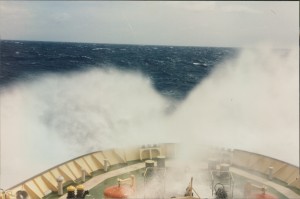
On and on we Sailed
On and on we sailed, and on and on the wind did blow,
It held its strength for days and days,
we passed close by Macquarie Island,
I do remember that peaceful night,
we once enjoyed at anchor here.
The wind had changed from North to West,
and hit the ship across the breast,
It meant the ship would roll er’r more,
so the captain changed cause to East by North
to ease the pain for all on board.
On and on we sailed again until we had to make a change,
and alter cause to Hobart Town.
The wind had eased to a steady blow
but still we rolled as on we go,
a somewhat lesser task to bare,
until we reached Tasmanian shores.
– Neale Beveridge
What a fantastic voyage this this has been, and the recalling of it all has bought back many memories, of the places and faces of those we met. I hope you too have enjoyed coming along with us.
